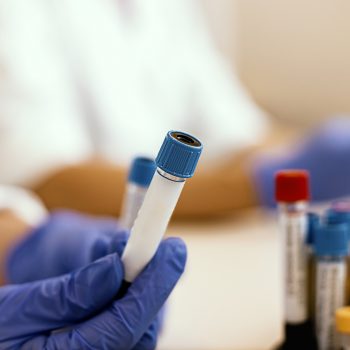It can appear at any age and affects those who are genetically predisposed. Coeliac disease in Italy affects 1 person in 100/150 but only a small part of the population is aware of the disease: the known coeliac sufferers are just over 70 thousand against a real number estimated at about 500 thousand. Although the frequency of diagnosis is increasing, thanks to the increasing application of diagnostic tests in clinical practice there is still a large population of patients who are not year of being so. Early diagnosis of celiac disease reduces the risk of complications related to the disease itself and the incidence of tumors of the gastreonteric tract, particularly intestinal lymphoma, which has a risk 30 times higher than normal in patients with celiac disease not on a diet. With Dr. Paoletta Preatoni, Autonomous Section of Clinical Gastroenterology at Humanitas, we talked about the serological diagnostics available, in particular a marker, represented by the deamidated antipeptide antibodies of gliadin DGP-AGA, which has replaced the native antigliadin antibodies and which is used in particular clinical circumstances and in childhood.
What is celiac disease?
Celiac disease is an immune-mediated systemic disorder caused by the ingestion of gluten present in some cereals including wheat, rye, barley and spelt, in genetically predisposed subjects. Gluten, in particular gliadin, activate the production of antibodies that trigger an inflammatory response that, as a final picture, leads to an atrophy of the intestinal villi, the structures responsible for the absorption of nutrients, with the consequent appearance of signs and symptoms that characterize this disease. These alterations are reversible from the moment the subject completely eliminates gluten from his diet.
Predisposition to disease and standard symptoms
Celiac disease is a disease that develops only in the presence of predisposing genetic factors: about 10-12% of first-degree relatives of celiac subjects are affected by this disease or have a risk of becoming ill at least 20 times greater than that of the general population. However, the genesis is polyfactorial, contributing to the development of the same immunological and environmental factors.
The symptoms are variable and may depend on the age of onset. For example, in pediatric age it may arise immediately after weaning (6-24 months of age), when gluten is introduced into the diet and manifesting itself with the typical symptoms of malabsorption: poor growth, chronic diarrhea, abdominal distension, asthenia, muscle hypotonia, lack of appetite, irritability. In school age it may present with recurrent abdominal pain, constipation or extra-intestinal manifestations such as short stature, puberty delay. In adults the presentation is even more varied ranging from non-specific disorders such as abdominal swelling, digestive difficulties, alternation of constipation and diarrhea to complete asymptomaticity with only alteration of laboratory tests (anemia or increased transaminases) or the presence of clinical pictures not related to the gastrointestinal tract (osteoporosis, infertility, headache).
Silent and latent coeliac disease
Silent coeliac disease is characterized by the positivity of serology and by the presence of minimal lesions at the level of the duodenal mucosa in patients who are totally asymptomatic and without alteration of laboratory tests; in general, these are patients who undergo serological screening as first-degree relatives of coeliac patients or those belonging to risk categories (Down’s syndrome, type I diabetes). Latent celiac disease is characterized by the absence of symptoms and signs of normal duodenal mucosa but positive serology.
Celiac disease in all its forms responds to the gluten-free diet with complete restitution ad interim of the duodenal mucosa one year after the start of the diet. There is a minimum percentage of patients who do not respond to the gluten-free diet (<1%) and who need medical treatment (cortisone and immunosuppressants). In this case we speak of refractory celiac disease and the patients are those at greater risk of developing lymphoma.
The new frontiers of diagnosis
The diagnosis of celiac disease involves several steps. Once the clinical suspicion is configured, the first step is the request of those who are in serological markers of the disease: antitransglutaminase antibodies (anti-tGT) of the IgA class and antiendomysium antibodies (EMA) always of the IgA class. If positive, the diagnosis, at present, must be confirmed histologically so that the patient must be subjected to EGDS with duodenal biopsies.
Serological diagnostics have been enriched with gliadin DGP-AGA Deamidated Antipeptide Antibodies which have replaced native gliadin antibodies ( AGA ). The sensitivity of this test is 84% for both IgA and IgG antibodies, and has a high specificity for IgG class (99%); moreover, although the PGD-AGAs show a lower sensitivity than EMA and anti-tTG, their specificity for IgG class is so high that they reach that of EMA IgA and exceed that of anti-tTG IgA.
How can these antibodies be included in the diagnosis of celiac disease?
The role of PGD-AGA class IgG in adults is not yet perfectly defined, certainly have a primary role in the screening of patients with immunoglobulin A deficiency in which anti-tTG and EMA IgA would be falsely negative because not produced (the deficiency of IgA is present in about 25 of celiac patients), could be used in follow-up instead of anti-tTG antibodies or have a role in the future where you could diagnose celiac disease without performing duodenal biopsy. This is in fact for example what already happens in children where if certain serological criteria occur the duodenal biopsy may be omitted.
Also in children, some papers argue that the PGD-AGA IgG should be the first antibody to be tested demonstrating that serum levels of these antibodies correlate with the degree of histological severity of the disease.








